Neem (Azadirachta indica) A Green Solution for Medicine, Agriculture, and Environmental Sustainability
Main Article Content
Abstract
Azadirachta indica, commonly known as neem, is a tropical evergreen tree widely recognized for its medicinal, agricultural, and industrial applications. Native to the Indian subcontinent, neem contains over 300 bioactive compounds including limonoids, triterpenoids, flavonoids, glycosides, and polyphenols. These compounds contribute to antioxidant, antimicrobial, anti-inflammatory, antidiabetic, anticancer, hepatoprotective, and wound-healing properties. Traditional systems like Ayurveda, Unani, and Siddha have utilized neem for centuries for skin infections, fevers, ulcers, diabetes, and gastrointestinal disorders. Modern pharmacology has isolated key phytochemicals such as azadirachtin, nimbolide, nimbin, and quercetin, which act via apoptosis induction, inflammatory pathway modulation, and microbial growth inhibition. Beyond healthcare, neem supports sustainable agriculture as a natural pesticide and soil enhancer. This review covers neem’s botanical traits, ethnobotanical importance, phytochemistry, pharmacology, agricultural significance, industrial applications, extraction techniques, toxicology, clinical trials, and prospects. The study bridges traditional knowledge with modern research, highlighting neem’s potential in health, environment, and industry.
Downloads
Article Details
Section

This work is licensed under a Creative Commons Attribution-NonCommercial 4.0 International License.

